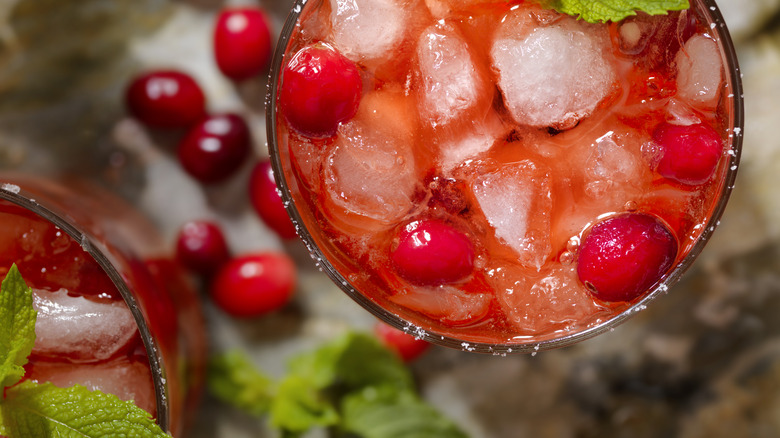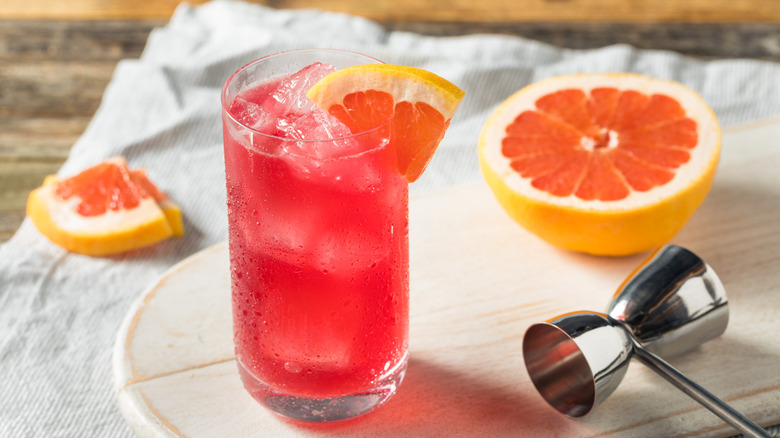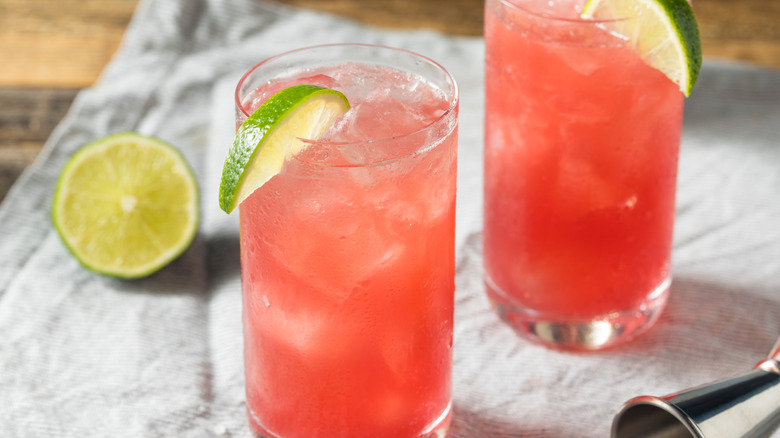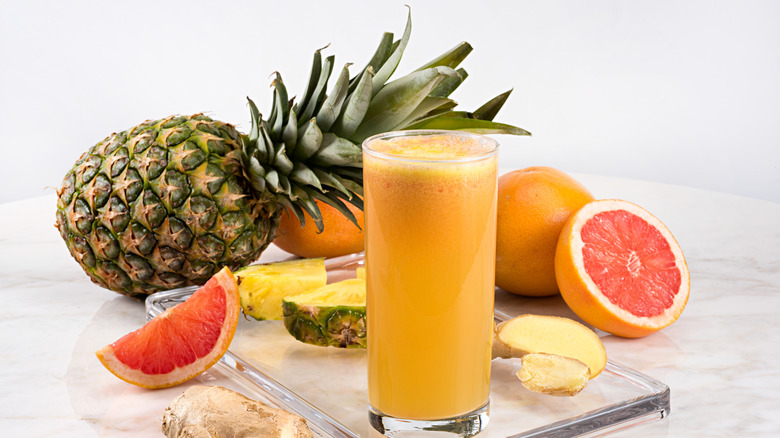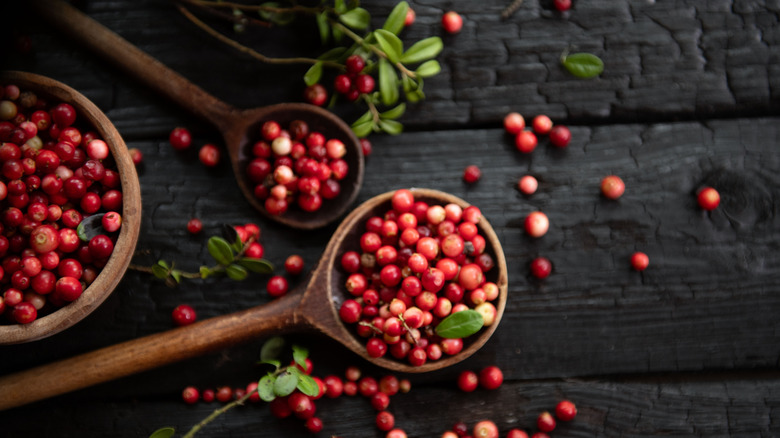What's The Difference Between A Sea Breeze And A Bay Breeze Cocktail?
When it comes to tropical drinks, breeze-themed names are queen. From the island breeze and ocean breeze to the classic hurricane cocktail (which is technically a type of breeze), it seems those sipping away in the sun prefer breezy beverages to quench their thirst. And why not? Few things evoke rest and relaxation better than the image of laying back with a drink in the fresh, warm air.
Both the bay breeze and sea breeze are particularly popular among bartenders and cocktail enthusiasts alike. Each cocktail starts with a vodka base mixed with the tart goodness of cranberry juice. From there, the drinks part ways by incorporating different tropical flavors to create two distinct and refreshing cocktails perfect for enjoying on a cruise or tropical vacation. Even if vodka isn't your favorite spirit, there are variations to each drink that allow you to customize it based on your personal preferences.
What is a sea breeze?
Today's sea breeze might be a simple, refreshingly fruity vodka cocktail, but the original recipe from the 1920s called for a gin base blended with grenadine, apricot brandy, and a squeeze of lemon juice. Though fruity and sweet, the vintage version was also boozier and likely packed more of a punch than current recipes.
The reason today's variation is so different from the 1920s recipe comes down to pesticides. In the 1960s, small amounts of aminotriazole — a weed-killer and known carcinogen — were discovered in cranberry bogs in the Pacific Northwest. Predictably, this led to a dramatic downturn in cranberry sales, which adversely affected cranberry producers, like Ocean Spray.
To restore cranberries' reputation and increase sales, Ocean Spray cleverly capitalized on vodka's growing popularity in the U.S. by marketing its famous cranberry juice as a delicious mixer for vodka-based cocktails. From this came the modern version of the sea breeze familiar to us today: equal parts vodka and grapefruit juice topped off with cranberry juice and served over ice. The juices soften the vodka's astringency without masking it too much, making it perfect for people who like a little bit of bite to their cocktails.
What is a bay breeze?
The bay breeze has been a mainstay of tropical beverage selections since the mid 1980s. Though it wasn't one of the recipes originally published as part of Ocean Spray's cranberry-positive marketing campaign, it was likely inspired by similar cocktails such as the Cape Codder (aka, vodka-cranberry), and the sea breeze itself. These cocktails pleased many palates and were easy to make, so it's no surprise variations like the bay breeze became popular.
Originating in Hawaii, the bay breeze is sweeter than its predecessors because it balances cranberry's sour undertones with juicy local pineapple. To make your own, add ice to a highball glass, followed by up to 2 ounces of vodka and equal parts cranberry and pineapple juice, then garnish with a wedge of fresh lime. You can also make a big batch of bay breezes for a crowd by combining 1 part vodka and 1 to 2 parts of each juice in a pitcher.
If you're not a fan of vodka or prefer intensely sweet cocktails, the Malibu bay breeze may be more your style. Though some think it's best to avoid flavored or spiced rums in tropical cocktails, the Malibu bay breeze is a popular variation of the classic that replaces plain vodka with coconut rum. You can also use coconut-flavored vodka to keep it closer to the original recipe.
Sippin' a sea change — where these cocktails diverge
Of course, the most obvious difference between these cocktails is that a sea breeze combines vodka and cranberry juice with grapefruit juice, while a bay breeze nixes the grapefruit juice for pineapple. This means a sea breeze is better suited to someone who prefers tangy cocktails with just a hint of sweetness, while a bay breeze works well for those who delight in sugary, tropical flavors that almost completely mask the taste of the vodka.
Another area where bay and sea breezes diverge is in their origins. The sea breeze is decades older, having originated during Prohibition. It was also first made with gin before Ocean Spray co-opted the name for its cranberry marketing campaign. Meanwhile, the bay breeze has always been a vodka-based drink, with variations that call for flavored rum.
These two cocktails frequently appear in very different regions of the United States. You're more likely to find the sea breeze on menus in cooler coastal regions like the Pacific Northwest and New England, as it pairs beautifully with savory seafood. Meanwhile, the bay breeze is popular in tropical destinations as the perfect complement to fruity desserts and beachside snacks.
Where breezes blend — similarities between two classics
The recipes for these two cocktails are incredibly similar — so much so that some people believe the bay breeze is simply a variation of the sea breeze. In fact, the bay breeze is sometimes called the Hawaiian sea breeze. This makes sense since both drinks include vodka and cranberry juice blended with another fruit juice.
Another similarity the two share is that they're seaside drinks. Though bay breezes hail from sunny beaches and sea breezes from rocky coasts, both evoke the feeling of being surrounded by crisp, salty air while gazing at the horizon. This is also likely why the word "breeze" made it into both names, since there's almost always a light wind coming from the ocean.
Finally, these breezy cocktails share a similar flavor profile. Though pineapple is sweeter than grapefruit, both fruits have plenty of tart acidity, which is highlighted by the signature sourness of cranberries. These strong flavors help balance the sharpness of bottom-shelf vodka, making the two drinks a sophisticated way to imbibe without going over budget.
